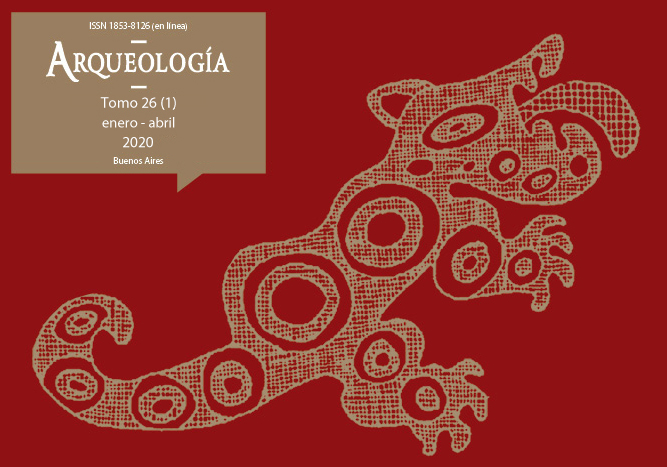Biodeterioro de cerámica arqueológica de superficie, valle de Antinaco central, La Rioja
Downloads
References
Colonna Preti, K. y Eeckhout, P. (2014). The bacteriological contamination of archaeological ceramics: an example from Pachacamac (Peru). En H. Roemich y K. van Lookeren Campaign (Eds.), Recent advances in glass, stained glass, y ceramics conservation (pp. 205-213). Londres: SPA Uitgevers.
Corbalán, M., Hladki, A. y Biasuso, A. (2017). Evaluación del deterioro antrópico y biológico en el petroglifo de Piedra Pintada, San Pedro de Colalao, provincia de Tucumán. Cuadernos del Instituto de Antropología y Pensamiento Latinoamericano -Series Especiales-, 5(2), 1-16.
De los Ríos, A., Cámara, B., García del Cura, M. Á., Rico, V. J., Galván, V. y Ascaso, C. (2009). Deteriorating effects of lichen y microbial colonization of carbonate building rocks in the Romanesque churches of Segovia (Spain). Science of the Total Environment, 407(3), 1123-1134. http://dx.doi.org/10.1016/j.scitotenv.2008.09.042
Gallego, M. y Oliva, F. (2005). Evaluación de agentes de deterioro biológico y cultural en los sitios en cuevas y abrigos rocosos del Sistema Serrano de Ventania, Provincia de Buenos Aires. Revista de la Escuela de Antropología, 11, 131-146.
Gorbushina, A. (2007). Minireview: life on the rocks. Envirommental Microbiology, 9(7), 1613-1631.
Guiamet, P. S., Crespo, M., Lavin, P., Ponce, B., Gaylarde, C. y Gómez de Saravia, S. G. (2013). Biodeterioration of funeral sculptures in La Recoleta Cemetery, Buenos Aires, Argentina: Pre- y post-intervention studies. Colloids y Surfaces B: Biointerfaces, 101, 337-342. http://dx.doi.org/10.1016/j.colsurfb.2012.06.025
Guiamet, P.S., Oliva, F., Gallego, M. y Gómez de Saravia S.G. (2008). Biodeterioration : an applied case for rock art in the Ventania Hill System (Buenos Aires, Argentina). O Público e o privado, 12, 105–120.
Guiamet, P. S., Soto, D. M. y Schultz, M. (2019). Bioreceptivity of archaeological ceramics in an arid region of northern Argentina. International Biodeterioration & Biodegradation, 141, 2-9. https://doi.org/10.1016/j.tele.2018.10.003
Magnin, L. A., Lynch, V. y García, R. (2017). Avances en el estudio de biodeterioro asociado a presencia de líquenes en materiales arqueológicos líticos. La Primavera (Santa Cruz, Argentina). Boletín de la Sociedad Argentina de Botánica, 52(3), 409-422.
Schiffer, M. B. (1983). Toward the identification of formation processes. American Antiquity, 48(4), 675-706.
Schiffer, M. B. (1987). Formation Processes of the Archaeological Record. Utah: University of Utah Press.
Seaward, M. (1988). Lichen damage to ancient monuments: a case study. Lichenologist, 20(3), 291-295.
Seaward, M. (2004). Lichens as Subversive Agents of Biodeterioration. En M. Seaward y S. Clair (Eds.), Biodeterioration of stone surfaces: lichens y biofilms as weathering agents of rocks y cultural heritage (pp. 9-18). España: Springer Netherlands.
Soto, D. M. (2015). Deterioro de fragmentos cerámicos por la acción de líquenes. En A. Piffereti y I. Dotzal (Eds.), Arqueometría argentina. Metodologías científicas aplicadas al estudio de los bienes culturales. Datación, caracterización, prospección y conservación (pp. 207-220). Buenos Aires: Aspha.
Soto, D. M. y Guiamet, P. S. (2017). Aplicabilidad de la conservación preventiva a la cerámica arqueológica impactada por biodeterioro. Cuadernos del Instituto de Antropología y Pensamiento Latinoamericano -Series Especiales-, 5(2), 71-90.
Soto, D. M., Guiamet, P. S. y Callegari, A. B. (2017). Biodeterioro de cerámica arqueológica de superficie por microorganisms de climas áridos y semi-áridos en el valle central de Antinaco, La Rioja. En A. Rochetti, F. Rivero y D. Reinoso (Eds.), Investigaciones Arqueométricas: técnicas y procesos (pp. 121-137). Ciudad Autónoma de Buenos Aires: Aspha.
Authors who publish in this journal agree to the following conditions:
- Authors retain copyright and yield to the journal right of first publication with the work registered with attribution license Creative Commons, which allows third parties to use the published always mentioning the authorship of the work and first publication in this magazine.
- Authors can make other independent and additional contractual arrangements for the non-exclusive distribution of the version of the article published in this issue (p. Eg., Inclusion in an institutional repository or publish it in a book), provided that clearly indicate that the work was published for the first time in this magazine.
- It allows and encourages the author / s to publish their work online (eg institutional or personal pages) before and during the process of revision and publication, as it can lead to productive exchanges and greater and more rapid dissemination of work published (See The Effect of Open Access).





(1)13.png)






1.jpg)
1.jpg)


13.png)
1.png)


(1)1.png)









